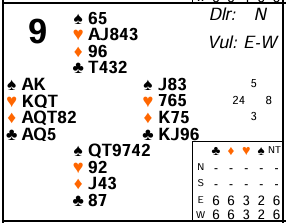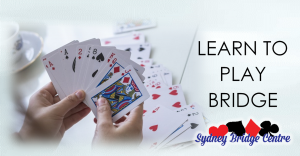City and Canada Bay – Thursday Morning 20th March 2025.
Last week I understand there was a mix up with boards so the City and Canada Bay sessions played different boards. I’ve looked at both sets and will include a hand from each this week. So effectively two short columns – with key points combined at the end.
Coincidentally board 9 in both sets had a slam available for East West although, as we’ll see, they are very different and they illustrate there are fundamentally two ways to make slam in bridge – power (i.e. points) or distribution.

CANADA BAY
First the Canada Bay board 9. Here slam makes due to raw power. East West have 32 points between them and 12 easy tricks losing just ♥A (5 diamonds, 4 clubs, 2 spades and 1 heart). Almost everyone played 3NT though.
The bidding is likely to be 3 passes to West (although South might consider opening 2♠ to make things a bit harder – see advanced section). West should open 2♣ – his hand is worth even more than 24 points as he not only has a 5 card suit but also has 3 aces and no jacks (in the traditional point count aces tend to be undervalued at 4 points and jacks tend to be overvalued at 1 point). If East responds a negative or waiting 2♦, West rebids 2NT which shows a hand too strong for whatever the pair’s 2NT opening would have been (most commonly that’s 20-22 so this is now 23+).
It’s a good idea to play 2♣ as a game force. That way West can rebid 2NT with an even bigger hand and still leave room for East to explore with stayman, transfers, etc. Yes that may occasionally mean you land in 3NT with 23 opposite 0 and go off. But that cost is more than outweighed by the extra room you gain all the other times the bid arises where you can now more easily find the right game or have room to find slam.
Over 2NT East in practice might just bid 3NT although he should be aware that’s also what he’d do with a far weaker hand. A better bid is 4NT (which should NOT be Blackwood here, it should just be invitational – see advanced section for why). West could then accept and offer 6♦ as a place to play – but here with 4333 East will probably go back to 6NT.
Another option might be for East to immediately bid 2NT over 2♣ – this is a positive response and usually shows 8+ balanced. West would probably then drive to slam. It’s not that common to do this though as it can risk wrong-siding a no-trump contract. Many pairs prefer to still respond 2♦ as a “waiting” bid just to find out what sort of game force partner has first. There’s still time to bid more later!
Although I said there are 12 easy tricks, one quiz to finish this hand. How should declarer play the diamond suit? See advanced section for the answer.
More advanced
Blackwood works well once a suit has been agreed. But its primary purpose is to stay out of slam if you happen to be missing 2 key cards. In sequences with 2 balanced hands where no suit has been agreed it is far better used as a quantitative invite. 2NT-4NT or 2♣-2♦-2NT-4NT for example.
On this hand diamonds break 3-2 so all is fine. But the technically correct play in the suit is ♦A first then a low one to the ♦K. That way, if North shows out, you are in dummy to take the marked finesse against South’s remaining ♦J9. If you’d started with ♦K, ♦A you’d find out the suit has split 4-1 but you are now in hand and have to use another entry to dummy to then take the finesse. On this hand that’s OK but on some hands there either might not be another entry or it may be needed for something else. What’s important to understand is that if North has ♦J9xx you can’t pick up the suit.
What about if South did open 2♠? West has to start with a double and this is where Lebensohl comes in handy. East can bid 3♣ but that’s showing 8+ (he’d bid 2NT with a weaker hand). Now West knows slam is highly likely. He could perhaps start with 3♦ but might even just jump straight to 6NT. Without Lebensohl West would have no way of knowing East had any values and would surely just end up in 3NT.
CITY
Now for the City board 9. Here East West can also make slam – 6♣. But this one is all about distribution not points. They only have 25 points and 2 of those (♥Q) are useless.
Assuming North passes (but, like the Canada Bay hand he might start with 2♥ to make things harder), East will open 1♣ and South will overcall 1♠. What should West do? One option is a cue raise (2♠) showing a good raise to at least 3♣. East has nothing more at this stage so will probably just bid 3♣. West might now try 3♦ (stopper showing, at that stage still fishing towards 3NT). When East can’t bid 3♥ or 3NT West knows they have no heart stopper so will have to play at least 5♣.
Another possible bid for West over 1♠ is 3♥ – if that shows a splinter (heart shortage and club support). However some pairs play this as a fit jump – see advanced section.
It’s the heart shortage and the 10 card fit that make 6♣ possible. If West can show the shortage, East should cue 4♦ next (denying a spade control but still showing interest). West should now recognise his ♠A is vital and drive further. To make 6♣, however, declarer needs to avoid a diamond loser. So he must drop the ♦Q in the South hand and not finesse. That’s not obvious but there are possible clues. Can you see what they are? Hint – think about the heart suit – both what might happen if you play the suit, and in the bidding.
In practice all the pairs that just gambled 3NT (most likely by bidding it directly over 1♠) did well because they received a spade lead which gave them 9 quick tricks (2 spades, 5 clubs and ♦AK). That of course turned into 11 tricks when ♦Q dropped. A heart lead would have been a very different story! This is always a dilemma for defenders. North on lead against 3NT will know West is probably prepared for a spade lead so might therefore try something else. On the other hand, a spade might be essential for the defence to set up their own tricks. There is, sadly, seldom a right answer – either approach can be right on any given hand!
More advanced
The point about the play of the heart suit is you may be able to find out where the honours are. Which might then in turn help with diamonds. For example if you lead low from West, North can see the singleton in dummy so might well rise ♥A if he has it. When he doesn’t and South wins ♥Q with the ♥A that strongly suggests North has ♥K (players normally win with the cheapest card available). Perhaps knowing North has ♥K might suggest South is more likely to have ♦Q?
That on its own may not help because these days South would probably have overcalled 1♠ on KJxxx AJxx xx Jx as well as on his actual hand! However, there are other clues. There are 10 hearts missing but no-one mentioned them in the auction. Why not? If South had had 55 in the majors he might well have made a Michaels cue bid over 1♣. So that might suggest South only has 4 hearts – which would give North 6. But then why didn’t North open 2♥? Perhaps because his hand was really bad and if he had his same hand with ♦Q he might be more likely to have opened 2♥? No guarantees of course but it’s this sort of detective work and “what if” questions trying to visualise the possible hands (and the minds of your opponents) that makes bridge at the more advanced levels such a fascinating game!
Here a 2♥ opening from North would make things very tough. East can’t really bid over that (he can’t double with only 2 spades and his clubs are dreadful for a 3 level overcall). South will raise to 3♥, possibly 4♥. West might make a takeout double of that but again it’s not obvious. Certainly East West reaching 6♣ will be almost impossible.
After 1♣ 1♠ it’s worth regular pairs discussing what jump bids in new suits mean. They don’t need to be natural (2♦ or 2♥ would normally be natural and forcing). So the two common usages are as splinters or as “fit jumps”. A fit jump typically shows 5 of the bid suit and good support for partner. Once again they help partner judge how well the hands fit (this time an honour in the bid suit is a good thing as it will help that suit be a source of tricks).
Key points to note (both hands)
Slam can make in bridge in two ways – raw power (32+ points) or distribution. Good bidders aim to reach slam with both hand types.
In the traditional point count aces tend to be undervalued at 4 points and jacks overvalued at 1 point. Mentally adjust the value of your hand a bit based on this (up if you hold several aces, down if you hold several jacks).
There are sometimes ways to play a suit to find out about a bad break and be in the right hand to deal with it. That can be critical if your entries are limited.
Showing shortages is often the key to bidding slams – it helps the other hand judge how well the hands fit. But “fit jumps” in competition can also be useful. It’s worth regular partnerships discussing these sorts of bids.
In balanced hand auctions where no suit is agreed 4NT is best used as an invite and not as Blackwood.
Playing on one suit may help you place the honours there. Which in turn may guide you to where the honours in another (critical) suit might be. The opponents’ bidding (or lack of it!) can also help.
Julian Foster (many times NSW representative) ♣♦♥♠





